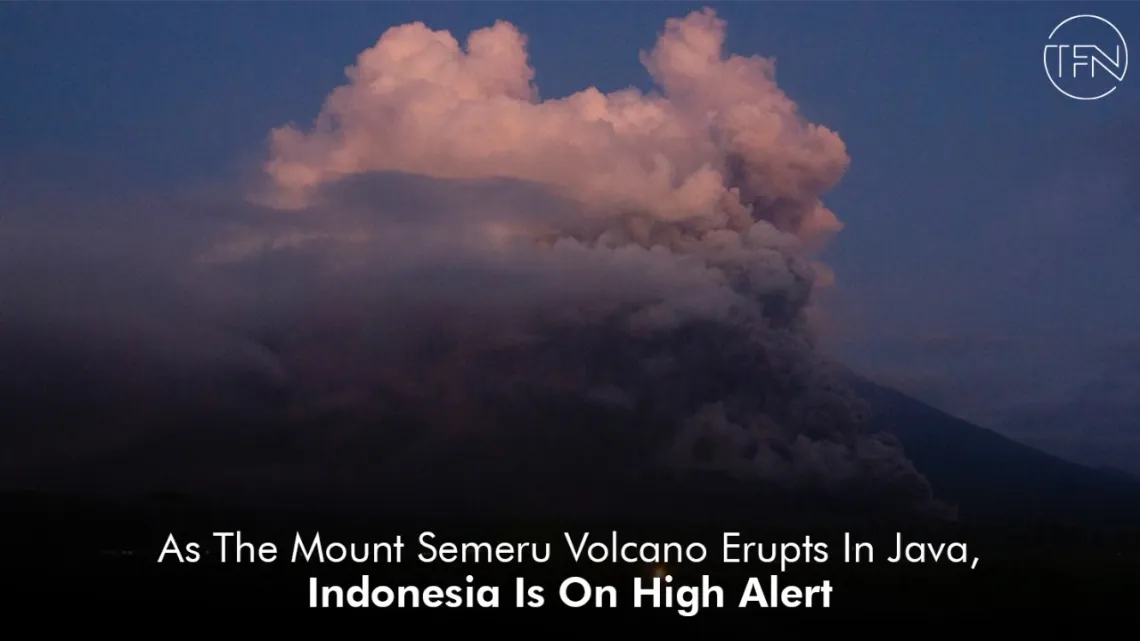Exactly one year after its previous massive eruption, which killed dozens, Indonesia's Mount Semeru erupted on December 4, spewing scorching ash clouds a mile into the sky and over 2,000 people had to be evacuated as lava rivers flowed down its flank.
The highest level of warning was raised by the government in response to the eruption of Java's tallest mountain, located around 800 kilometers (500 miles) southeast of Jakarta.
After the eruption, "hot avalanches" generated by lava piles at the 3,676-meter (12,000-foot) volcano's summit fell, according to National Disaster Mitigation Agency (BNPB) spokesperson Abdul Muhari.
According to Volcanology and Geological Disaster Mitigation Center (PVMBG) spokesperson Hendra Gunawan, the heightened hazard level "means the danger has jeopardized the people's settlement and the volcano's activity has risen."
No fatalities or injuries were recorded in the immediate aftermath of the eruption, but after the hazard level was upgraded to 4, Gunawan issued a warning to locals not to travel up to five miles (8 km) from the crater.
At least six villages were reportedly affected by the eruption, and the BNPB reported that 1,979 people were taken to 11 shelters.
Images on neighborhood television showed evacuees, primarily women, and children, finding safety in a school.
Videos supplied by AFP from the local rescue group Irannala Rescue showed a huge black cloud rising from the volcano's crater, engulfing the sky and blocking the sun in nearby communities.
According to Kompas, during the afternoon, monsoon rains were pelting the settlements and mixing with volcanic ash.
Additionally, a southeasterly region 13 kilometers (8 miles) along a river in the direction the ash was traveling was advised against by locals.
The local administration chief for Lumajang, where the volcano is located, Thoriqul Haq, said that "a lot of people have started to go down."
Patria Dwi Hastiadi, the spokesperson for the Lumajang Disaster Mitigation Agency, said the majority of inhabitants in the two most at-risk villages had already left on their own.
The southern islands of Miyako and Yaeyama in the prefecture of Okinawa had previously received a tsunami alert from Japan's weather service, according to the Kyodo news agency. The nation's meteorological bureau, however, insisted that no discernible tidal changes had been observed.
After the eruption, an AFP journalist said that the internet was down and phone reception was spotty in the Semeru area.
The local rescue agency distributed free masks to the general population of the danger that polluted air posed to surrounding residences.
A video captured the sky suddenly becoming pitch black as a massive ash plume consumed any light as rescuer Gunawan, who shares the same name as the PVMBG spokesperson, after the eruption, observed clouds above him in East Java.
Invoking the eruption from the previous year, he assured them in a Javanese dialect, "I've promised you, we won't miss it again," before flashing a peace sign at the camera.
Around midday, a different rescuer saw a terrifyingly dark scene outside that could as well have been midnight.
He addressed the camera, saying, "It's getting dark, bro," as a seismograph whirred in the distance.
The last time Mount Semeru erupted, at least 51 people were killed, and more than 5,000 dwellings were damaged.
Nearly 10,000 people fled for safety as homes and cars were submerged in mud and ash that coated entire streets.
According to a PVMBG media officer, a bridge that connects two districts in the area and was being restored following last year's eruption was severely damaged once again on Sunday.
Since its previous significant eruption in December 2020, which also drove thousands of people to evacuate and blanketed villages, Semeru's alert status has remained at its second-highest level.
In the Pacific Ring of Fire, where Indonesia is situated, continental plates meet, resulting in fierce volcanic and seismic activity.
There are roughly 130 active volcanoes in this group of Southeast Asian islands.
More than 400 people lost their lives as a result of an undersea landslide and tsunami that were caused by the eruption of a volcano in the strait between the islands of Sumatra and Java in late January 2018.

